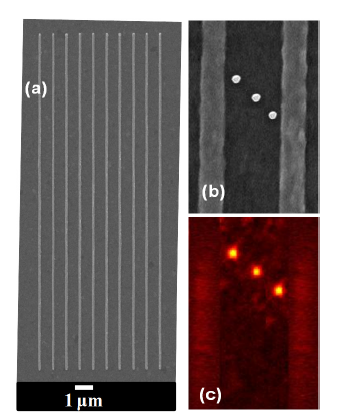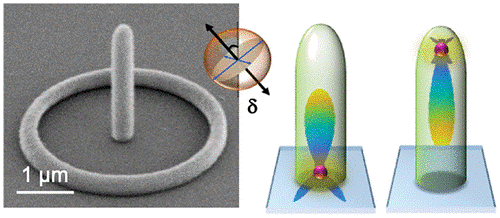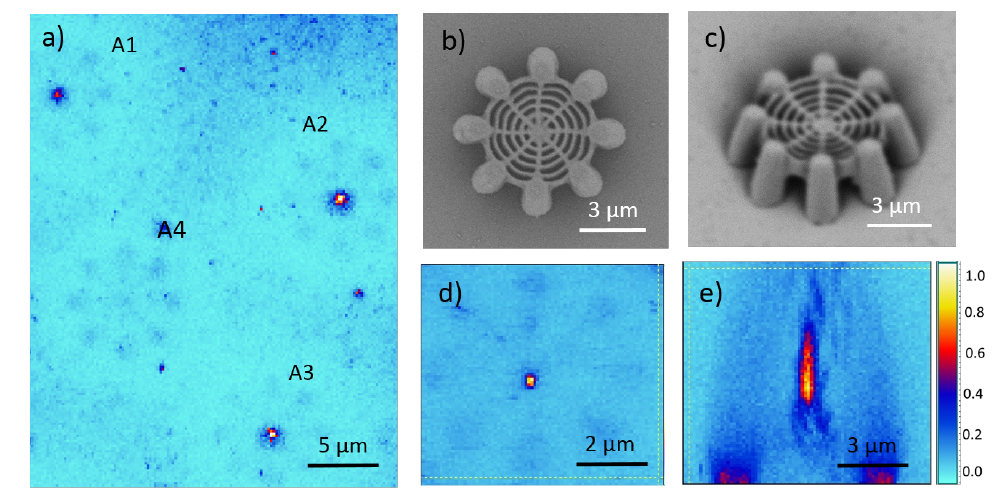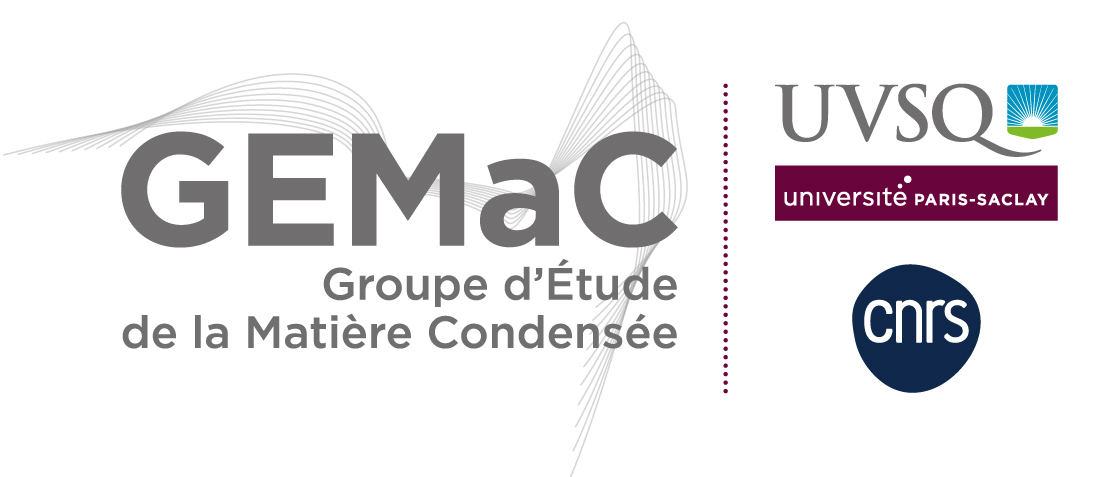1. Fluorescence properties of single NCs coupled to metallic structures
In collaboration with the LICB (University of Burgundy) and the LPEM, we obtained several important results concerning the coupling between NCs and gold metallic structures:
• On structures associating micro-gratings and NCs (figure 1), we have shown the emission of single photons or the emission of radiative cascades according to the importance of the coupling NCs / metallic structure [1,2]. The polarization rate can also reach 90 % and the Purcell factor is around 3. Simulations allow to model the experimental results. These studies also lead to the understanding that the grating induces a double effect of decoupling and acceleration of the emission. This metallic structure can also be optimized to drastically reduce the influence of the position of the NC.

Fig 1. Image by electron microscopy of a grating structure (a) and of NCs (b). Corresponding fluorescence image (c). [2]
• We have studied in detail the properties of a guide acting as a microlens, allowing very efficient coupling of the surface plasmon excited by the NCs in a TiO2 guide. We have measured a multiplication by a factor of 2 of the emission collected thanks to this approach [4].
• We have developed a data post-processing method which allows us to analyze in detail the intensity autocorrelation function of an emitter alternating between two emission states of the same intensity. The antibunching for each state is determined using the difference between their respective photoluminescence decay rates. This method was applied to an individual NC coupled to a plasmon resonator and allowed to determine the relative quantum efficiencies of the neutral and charged biexcitons [5].
• We also examined the modifications of the emission of the NCs when they are deposited on a plane gold film at 4K [6]. We have shown a significant reduction in optical losses induced by the Joule effect in metal. The radiative quantum efficiency is multiplied by 3 at 4K, the result being in agreement with theoretical predictions based on the variation of the dielectric permittivity of the metal. Recently, we have shown that the quantum efficiency can still be multiplied by a factor of around 2 using crystalline gold platelets [6].
2. Coupling a single NC with a 3D polymeric nanophotonic structure
As part of the Labex NanoSaclay, in collaboration with Ngoc Diep Lai from LPQM, we are working on the integration of NCs in photonic structures made in a resist (SU8) by an original technique called LOPA for Low One Photon Absorption. By exposing the resist using a focused 532 nm laser, the LPQM team can define 3D architectures with a resolution well below 200 nm.
The LOPA technique was used to fabricate different 2D structures containing NCs. After having shown that the NCs inserted in an SU8 matrix and excited at 532 nm were photostable and exhibited no blinking [7,8], we optimized the emission of NCs integrated in nano-antennas. We have obtained a photon collection efficiency greater than 90 % [9]. By using bull-eye cavities, we have also managed to boost the spontaneous emission rate by a factor of around 4.

Fig 2. Electron microscopy image of a nano antenna and two examples of the radiation pattern of a NC integrated in the nano antenna.

Fig 3. Nanocrystals integrated in “bull-eye” type cavities. (a, d) Fluorescence images. (b, d) Electron microscopy images. (e) Radiation diagram.
[1] F. Eloi, H. Frederich, F. Mazéas, A. Kumar, S. Buil, X. Quélin, A. Bouhelier, J.C. Weeber, M. Nasilowski, B. Dubertret, G. Colas des Francs, and J.-P. Hermier,
"Enhanced and polarized emission from single colloidal CdSe/CdS nanocrystals coupled to a 1D gold grating",
Phys. Rev. B 94, 085301 (2016)
[2] A. Kumar, J-C. Weeber, A. Bouhelier, F. Eloi, S. Buil, X. Quélin, M. Nasilowski, B. Dubertret, J.-P. Hermier, and G. Colas des Francs,
"Spatially uniform enhancement ofsingle quantum dot emission using plasmonic grating decoupler",
Scientific Reports 5, 16976 (2015)
[3] S. Derom, A. Bouhelier, A. Kumar, A. Leray, J-C. Weeber, S. Buil, X. Quélin, J.-P. Hermier and G. Colas des Francs,
"Single molecule controlled emission in planar plasmonic cavity",
Phys. Rev. B 89, 035401 (2014)
[4] J.-C. Weeber, K. Hammani, G. Colas Des Francs, A. Bouhelier, J. Arocas, A. Kumar, F. Eloi, S. Buil, X. Quélin, J.-P. Hermier, M. Nasilowski, B. Dubertret,
"Colloidal quantum dot integrated light sources for plasmon mediated photonic waveguide excitation",
ACS Photonics 3, 844 (2016)
[5] F. Eloi, H. Frederich, A. Leray, S. Buil, X. Quélin, B. Ji, E. Giovanelli, N. Lequeux, B. Dubertret, and J.-P. Hermier,
"Unraveling the time cross correlations of an emitter switching between two states with the same fluorescence intensity",
Optics Express 23, 29921 (2015)
[6] A. Coste, F. Eloi, G. Colas des Francs, X. Quélin, S. Buil, A. Bouhelier, J-C. Weeber, M. Nasilowski, B. Dubertret, J-P. Hermier,
"Significant decrease of the optical losses in the coupling between colloidal CdSe/CdS nanocrystals and a flat gold film at cryogenic temperature",
Phys. Rev. B 96, 195416 (2017)
[7] T. H. Au, S. Buil, X. Quélin, J-P. Hermier, N. D. Lai,
"Suppression of grey state and optimization of the single photon emission of a colloidal semiconductor at room temperature",
Appl. Phys. Lett. 113, 111105 (2018)
[8] T. H. Au, S. Buil, X. Quélin, J-P. Hermier, N. D. Lai,
"Photostability and long-term preservation of colloidal semiconductor-based single photon emitter in polymeric photonic structures",
Nanoscale Adv. 1, 3225 (2019)
[9] T. H. Au, S. Buil, X. Quélin, J-P. Hermier, N. D. Lai,
"High directional radiation of single photon emission in dielectric antenna",
ACS Photonics 6, 11 (2019)








